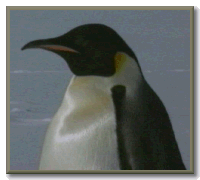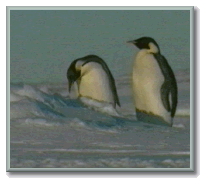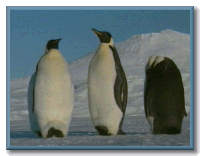Emperors are the largest of all penguins in size. They are about one meter tall and weigh approximately 30-40 kilograms. They have a black head, a blue-gray neck with a bright orange patch near the ears and pale yellow breast fading into white. Emperors are bigger and chick-rearing takes longer than it does for the smaller Adelies. Chicks need to be independent by summer when food sources are most plentiful, so the eggs have to be laid early. In the southern autumn (April-May) colonies assemble on the sea ice in sheltered bays. A single egg is laid in May or early June and is incubated by the male for two months over the coldest part of the year. The egg is kept on top of the male's feet covered by a flap of blood-rich skin and feathers to keep it warm in temperatures down to -50°C. The male doesn't eat during this time; it would use too much energy to go back and forth across many kilometers of ice to the sea if incubation duty was shared with the females. Instead they have adapted to these extreme conditions by huddling together in huge groups and using their reserves of fat for energy and insulation.
|
|
|
The females return to the colony when the chicks hatch and then both parents take turns crossing the ice to the sea to feed and to bring back food for the chick. By January or early February the chicks lose their downy feathers and, although not fully grown, are ready to fend for themselves in the sea. They spend their first two years of life at sea or on the pack ice.
|
The Emperor penguin is unique among Antarctica's birds. It breeds in winter, on the ice along the coast of the continent and at one colony at the base of the Antarctic Peninsula, when weather conditions are at their worst and in almost continuous darkness. These penguins do not build a nest or defend a fixed territory. Instead the male incubates the egg on its feet and can shuffle around as required. During very cold periods the incubating birds form dense huddles to conserve heat. The chicks leave the colonies in spring, while still molting their down, and are rafted out to sea on broken pieces of pack ice. Like the larger petrels, penguins do not breed until several years old and may live 30 to 40 years.
|
|
|
WANT TO LEARN MORE?
|
|
Websites
• Emperor Penguins Information on the Emperor penguin including taxonomy. • Antarctic Penguins Images, basic information and the sounds of penguins. • Waddling is a good way to make up for short legs Press release explaining that scientists have discovered that the penquin waddle helps the animal save energy. • Life at Sea: At Home in the Ocean Basic information on penquins, their life at sea, blackfooted penguins in peril and an FAQ on penguins. • Nature: The World of Penguins Information about penguins, how to protect them and how they are so graceful in water. • Pete and Barbara's Penguin Pages Information on penguins including their life cycle, how they are threatened and where to see them. • Antarctic Biology General information on the animals of Antarctica including krill, fish, birds, penguins and seals. • Penguins Basic information on penguins. |
![]()


